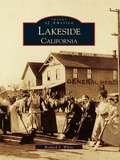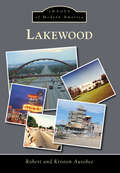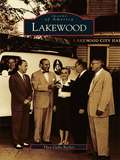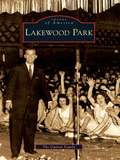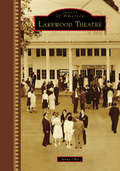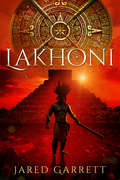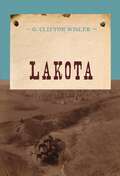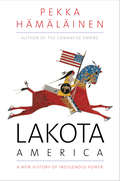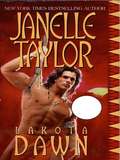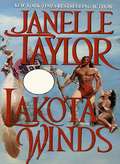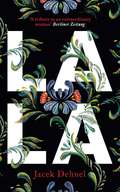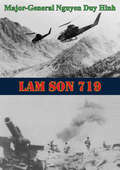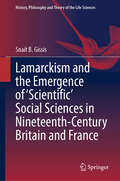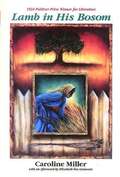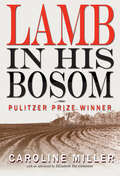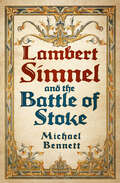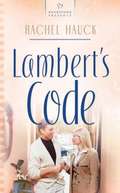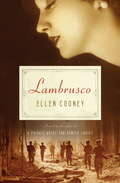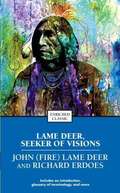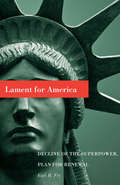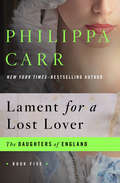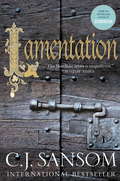- Table View
- List View
Lakeside, California
by Richard S. WhitePurchased by the El Cajon Valley Land Company in 1886, Lakeside began as a small hamlet along the banks of the San Diego River. Home to the only natural lake in San Diego County, Lakeside offered visitors throughout the century a scenic backdrop for boating, fishing, hunting, riding, and hiking. Captured here in over 200 vintage images is the history of this town located just 25 miles east of San Diego. After the San Diego Mission was established in 1769, the Padres explored the backcountry, seeking grazing lands for their livestock. Following the San Diego River upstream they came to a broad valley, which they named El Cajon, "the box." In 1886, 6,600 acres were sold to the El Cajon Land Company for the Lakeside town site and a large inn was built as a resort. Due in large part to the trains coming through Lakeside in 1889, Lakeside had become a thriving community by the turn of the century.
Lakewood
by Robert Autobee Kristen AutobeeAlthough settled in the mid-1860s, Lakewood waited to incorporate until 1969, when its population was 90,000. It was instantly the third largest city in Colorado and had it all. Lakewood even had progressive ideas for government from a nonmilitarized police department to incorporation of the patchwork of existing sewer, water, fire protection, and park districts. And if it did not exist, Lakewood's community-minded citizens created organizations, committees, and associations, like the historical society and Lakewood on Parade, to fill the need. This can-do entrepreneurial spirit makes Lakewood a livable, small-town, "All-America" city.
Lakewood (Images of America)
by Thea Gallo BeckerNamed for its natural setting on the south shore of Lake Erie, Lakewood, Ohio was one of Cleveland's original suburbs. Incorporated as a city in 1911, Lakewood experienced tremendous growth during the early 20th century, and became known as "Cleveland's Fashionable Suburb," and a "City of Beautiful Homes," as it boasted some of the finest Victorian residences in the area. Using a wonderful collection of historic photographs, many from the Lakewood Historical Society, the pages of this book take you on a tour of Lakewood's history, chronicling the people, places, and events that have made the suburb one of the area's best places to live.
Lakewood Park (Images of America)
by The Guinan FamilySituated in the coal regions of northeast Pennsylvania, Lakewood Park was established in 1916 by the Guinan family as a place to bathe, picnic, and camp. It became known as a nature retreat for the nearby miners and their families, and it developed into the destination for swimming, amusement rides, skating, big band dances, boxing matches, ethnic celebrations, summer stock plays, and political banquets. The park boasted a 150-yard cement pool, hand-carved Spillman carousel, and grand ballroom. It was the host of the longest-running ethnic festival in Pennsylvania, Lithuanian Day, from 1914 to 1984. Using vintage images, Lakewood Park recalls the various festivals and celebrations, amusements rides, and celebrity performers, such as Dick Clark and Doris Day, that made the park an entertainment mecca for 68 years.
Lakewood Theatre (Images of America)
by Jenny ObyBeginning as a humble vaudeville hall in the Skowhegan-Madison trolley park, Lakewood Theatre has graced the southwestern shore of Lake Wesserunsett in Madison, Maine, since the turn of the 20th century. Under the masterful guidance of Herbert L. Swett, a Bangor native and Bowdoin graduate, Lakewood eventually developed into a nationally renowned playhouse that was called the “Broadway in Maine” by the New York Times in its heyday, from 1925 until World War II. In the years following the war, Lakewood was operated by Swett’s heirs and became a virtual who’s who of both Broadway and Hollywood, until it nearly went dark in the early 1980s. Operating today as a nonprofit community theater, Lakewood is the official state theater of Maine and the oldest continually running summer theater in the country.
Lakhoni
by Jared GarrettLakhoni has been left for dead. When the King's guards attack his village and slaughter his people, he regains consciousness only to find his sister has been taken captive. Armed with only a bow, Lakhoni must traverse a brutal wilderness, face deadly warriors, and battle legendary tattooed assassins, all in order to save his sister's life. But along the way, he discovers his parents were not the simple villagers they seemed. Instead, they were hiding a great secret that goes back to the First Fathers. Lakhoni sets out to avenge his parents, but he isn't the only one who wants the king dead. Ancient enemies are poised to strike while traitors poison the kingdom from within. The life of the king and the fate of the kingdom hang in the balance.
Lakota (An Evans Novel of the West)
by G. Clifton WislerMastincala, the Rabbit Boy, is born in a tumultuous and uncertain time for his people, the Lakota. He is but a boy when his father is killed during the clash between the Lakota and Colonel Harney&’s army at Rosebud, and he vows to avenge his father&’s death. Mastincala joins Crazy Horse and the Oglala on their rides against the Crow, fighting against the encroachment and overhunting of Big Horn country. He earns the name Tacante, Buffalo Heart, for his courage during one particularly fierce battle, and sheds his softer boyhood persona. When gold is discovered in the sacred Black Hills, a series of unstoppable events is set in motion—culminating in the bloody massacre at Little Big Horn. In the midst of the turmoil, Mastincala must decide how to forge a future for his family while defending the honor and tradition of his ancestors.Lakota vividly details the struggle of the Lakota people against the white man for control of their hunting grounds, and offers a moving, bittersweet portrait of the period that marked the end of a way of life for the Plains Sioux.
Lakota America: A New History of Indigenous Power (The Lamar Series in Western History)
by Pekka HamalainenThe first comprehensive history of the Lakota Indians and their profound role in shaping America’s history This first complete account of the Lakota Indians traces their rich and often surprising history from the early sixteenth to the early twenty‑first century. Pekka Hämäläinen explores the Lakotas’ roots as marginal hunter‑gatherers and reveals how they reinvented themselves twice: first as a river people who dominated the Missouri Valley, America’s great commercial artery, and then—in what was America’s first sweeping westward expansion—as a horse people who ruled supreme on the vast high plains. The Lakotas are imprinted in American historical memory. Red Cloud, Crazy Horse, and Sitting Bull are iconic figures in the American imagination, but in this groundbreaking book they emerge as something different: the architects of Lakota America, an expansive and enduring Indigenous regime that commanded human fates in the North American interior for generations. Hämäläinen’s deeply researched and engagingly written history places the Lakotas at the center of American history, and the results are revelatory.
Lakota Dawn (Lakota Winds #2)
by Janelle TaylorFrom New York Times bestselling author Janelle Taylor, comes her most compelling Native American saga. Taking you to an unforgettable time and place, the Great Plains of 1854, this magnificent novel of a proud warrior who must reclaim his heritage and the woman he is destined for, will move you with its breathtaking beauty and spellbinding passion. . . LAKOTA DAWNCloud Chaser was merely a boy of ten when a cruel twist of fate took him away from his family and changed his life forever. Now, after twelve years, he has returned home. Struggling to gain the trust and acceptanceof his tribe, Cloud Chaser is ready to face any obstacle to fulfill his dream of riding with the Lakota. But he never expects to lose his heart to the beautiful Indian maiden Dawn, who shared his wish of bringing peace to the Black Hills. Now as an even greater challenge awaits him, he and Dawn together strive to secure the future of their people-and their love. . ."A STORY THAT WILL THRILL."-Romantic Times
Lakota Flower (Lakota Winds #3)
by Janelle TaylorA chief&’s son is willing to accept his bloody destiny—but struggles with forbidden desire—in this series finale from the New York Times–bestselling author.Threatened by the ever-encroaching Bluecoats, the Oglala Lakotas must strike hard and fast to ensure their tribe&’s survival. With the cunning and bravery befitting a chief&’s son, War Eagle leads his hunting party on a raid, killing many soldiers and taking a white woman captive. Caroline Sims has hair as bright as the sun and the courage of a wildcat, sparking a forbidden attraction in the fierce warrior. In a land where danger lurks in every shadow and peace often comes at a deadly price, War Eagle and Caroline find themselves locked in a passionate battle for their lives—and their love . . .Praise for Lakota Dawn &“A story that will thrill.&” —Romantic Times
Lakota Winds (Lakota Winds #1)
by Janelle TaylorA foretold marriage between two widowed Lakota could save their tribe in this romance series opener by the New York Times–bestselling author.When his wife and young son are slaughtered by Crow warriors, Wind Dancer is let embittered and lonely. Intent only on duty to his people, he never imagines that it will force him to take another woman into his life.Chumani too has lost much to tribal wars. Seeking revenge for the murder of her husband and child, the beautiful warrior rides fiercely against her enemies, and vows never again to marry. But when a medicine man sees her union with Wind Dancer in a sacred vision, she knows their alliance will make both their tribes strong. Now, beneath the wide sky of a land at war with itself, Wind Dancer and Chimani must learn to trust again-and to succumb to a love that can heal—if they ever hope to save their people.
Lala
by Jacek DehnelA lyrical and moving Polish family saga set against the turbulent backdrop of twentieth-century Europe Lala has lived a dazzling life. Born in Poland just after the First World War and brought up to be a perfect example of her class and generation – tolerant, selfless and brave – Lala is an independent woman who has survived some of the most turbulent events of her times. As she senses the first signs of dementia, she battles to keep her memories alive through her stories, telling her grandson tales of a life filled with love, faithlessness and extraordinary acts of courage. Sweeping from nineteenth-century Kiev to modern-day Poland, Lala is the enthralling celebration of a beautiful life.
Lam Son 719 [Illustrated Edition]
by Major-General Nguyen Duy HinhIncludes over 30 maps and illustrationsFor several years, the eastern part of the Laotian panhandle was used by North Vietnam as a corridor for the infiltration of personnel and materiels required to sustain its war efforts in South Vietnam and Cambodia. In addition to the Ho Chi Minh Trail, the eastern panhandle contained many logistic installations and base areas. After the 18 March 1970 change of government in Cambodia which closed the port of Sihanoukville to the enemy, this trail-base area complex in lower Laos became even more important to North Vietnam in its prosecution of the war in the South. The real hub of this entire complex, where transportation and storage activities were coordinated, was Base Area 604 located west of the Demilitarized Zone and surrounding the district town of Tchepone.To disrupt the flow of enemy personnel and supplies into South Vietnam, a ground attack was launched across the Laotian border against this enemy hub of activity on 8 February 1971. Operation LAM SON 719 was conducted by I Corps with substantial U.S. support in firepower and heli-lift but without the participation of U.S. advisers with those ARVN units fighting in Laos. As a test of Vietnamization, this operation was to demonstrate also the progress achieved in combat effectiveness by the Republic of Vietnam Armed Forces. Further, LAM SON 719 achieved the objective of forestalling a Communist offensive in the spring of 1971.
Lamarckism and the Emergence of 'Scientific' Social Sciences in Nineteenth-Century Britain and France (History, Philosophy and Theory of the Life Sciences #36)
by Snait B. GissisThe book presents an original synthesizing framework on the relations between ‘the biological’ and ‘the social’. Within these relations, the late nineteenth-century emergence of social sciences aspiring to be constituted as autonomous, as 'scientific' disciplines, is described, analyzed and explained. Through this framework, the author points to conceptual and constructive commonalities conjoining significant founding figures – Lamarck, Spencer, Hughlings Jackson, Ribot, Durkheim, Freud – who were not grouped nor analyzed in this manner before. Thus, the book offers a rather unique synthesis of the interactions of the social, the mental, and the evolutionary biological – Spencerian Lamarckism and/or Neo-Lamarckism – crystallizing into novel fields. It adds substantially to the understanding of the complexities of evolutionary debates during the last quarter of the nineteenth century. It will attract the attention of a wide spectrum of specialists, academics, and postgraduates in European history of the nineteenth century, history and philosophy of science, and history of biology and of the social sciences, including psychology.
Lamb in His Bosom
by Caroline MillerIn 1934, Caroline Miller's novel LAMB IN HIS BOSOM won the Pulitzer Prize for Literature. It was the first novel by a Georgian to win a Pulitzer, soon followed by Margaret Mitchell's GONE WITH THE WIND in 1937. In fact, LAMB was largely responsible for the discovery of GONE WITH THE WIND; after reading Miller's novel, Macmillan editor Harold S. Latham sought out other southern novels and authors, and found Margaret Mitchell.<P><P> Caroline Miller was fascinated by the other Old South-not the romantic inhabitant of GONE WITH THE WIND, but rather the poor people of the south Georgia backwoods, who never owned a slave or planned to fight a war. The story of Cean and Lonzo, a young couple who begin their married lives two decades before the Civil War, LAMB IN HIS BOSOM is a fascinating account of social customs and material realities among settlers of the Georgia frontier. At the same time, LAMB IN HIS BOSOM transcends regional history as Miller's quietly lyrical prose style plays poignant tribute to a woman's life lived close to nature-the nature outside her, and the nature within.<P> Pulitzer Prize Winner
Lamb in His Bosom (Modern Southern Classics Ser.)
by Caroline MillerThe 1934 Pulitzer Prize-winning novel about a young newlywed woman struggling with her harsh life in rural, impoverished antebellum Georgia."It has a wonderful freshness about it.... A wonderfully large and vital picture." ―The New York TimesCean and Lonzo are a young couple beginning their married lives two decades before the Civil War in a land where nature is hostile, the seasons dictate the law, and the days are punctuated by the hard work of the land. The couple's only wealth is their hands, their obstinacy, and their love.By the time Cean is forty-three, she has borne fourteen children; buried five of them and her husband; and survived a civil war, venomous snakebite, ferocious panther attack, and a deadly house fire. Neither life nor the din of history has spared her.In her lyrical, fascinating story (winner of the 1932 Pulitzer Prize for Literature), author Caroline Miller explores the struggle and survival of impoverished settlers in pre-Civil War South Georgia. A thought-provoking addition to American, Civil War, and Women's History studies.
Lambert Simnel and the Battle of Stoke
by Michael BennettWithin two years of the battle of Bosworth, Henry Tudor was forced to defend his throne against a formidable challenge mounted on behalf of a ten-year-old boy who had been crowned in Dublin as ‘Edward VI’. Though presented as the last surviving Plantagenet, the young lad is generally known to history as Lambert Simnel.Lambert Simnel and the Battle of Stoke unravels the tangled web of dynastic politics and rivalries in Yorkist England, seeking a context for the bizarre events of 1487. It considers the political instability and the miasma of intrigue associated with the reign of Richard III and the first years of Henry VII. It seeks to probe the mysteries surrounding Lambert Simnel, raising questions about his identity and the roots and ramifications of the movement that centred on him. Above all, it charts the progress of the conspiracy and rebellion, from the raising of troops in the Netherlands and Ireland to the ‘coronation’ in Dublin in May 1487, from the invasion of northern England through to the final, bloody encounter outside the village of East Stoke, near Newark, in June. Henry’s triumph in the field, the last occasion when an English king personally took to the field against a rival, marked an important stage in the development of Tudor polity.In this revised and updated edition, Professor Michael Bennett offers new information and insights on this remarkable episode in English history, seeks clarity and coherence in accounts of the fast-moving drama, re-examines old and new evidence, including misconceptions and misinformation, and addresses recent theories regarding the identity of the Dublin king.
Lambert's Code
by Rachel HauckAfter three years of medical treatment, Julie Lambert faces the irrefutable truth: She will never have children. Devastated, lost, and alone, she buries her pain by making several life decisions that threaten her relationship with her husband, Ethan.
Lambert's Peace
by Rachel Hauck"Will needs our help, Betty." She sat down and placed her hands in her lap. "You got ten minutes. Cookies are in the oven." Will laughed. "Tell me how to win Taylor. She thinks our time has passed. Too late. Lost what we once had." Grandma waved her hand. "Taylor's easy, Will. She already loves you. I can see it in her eyes. You just need to let her know that no matter what, you're going to be there for her. Never let her go. Prove whatever happened between you ten years ago won't happen again." Will grinned. Simple. Wise. Brilliant. Hopefully, not impossible.
Lambrusco: A Novel
by Ellen CooneyThe year is 1943. The Nazis have invaded Italy; American troops have landed. At Aldo's restaurant on the Adriatic coast, Lucia Fantini entertained customers for years with her marvelous opera singing. But normal operations are over. The restaurant has been seized by nazifascisti, and a Resistance squad of waiters and local tradesmen has been formed, led by Lucia's son, Beppino. When Beppino disappears, Lucia must journey across war-devastated Italy to find him. Aided by a richly drawn cast of characters, the story of her adventures is told with the vigor, drama, and lyrical grace of an Italian opera, in a brilliantly arranged narrative that places tragic events side-by-side with high comedy, domestic intrigues, and gripping details. In this captivating story of a mother and son, Cooney enters a world of peril and chance, and brings to life the extraordinary Resistance movement of the Italian people.
Lame Deer, Seeker Of Visions (Enriched Classics Ser.)
by Richard ErdoesLame Deer--Storyteller, rebel, medicine man. Lame Deer was born almost a century ago on the Rosebud Reservation in South Dakota. A full-blooded Sioux, he was many things in the white man's world -- rodeo clown, painter, prisoner. But, above all, he was a holy man of the Lakota tribe. The story he tells is one of harsh youth and reckless manhood, shotgun marriage and divorce, history and folklore as rich today as ever -- and of his fierce struggle to keep pride alive, though living as a stranger in his own ancestral land.
Lament For a Lost Lover
by Philippa CarrUnder the sway of the puritanical Oliver Cromwell, England simmers with religious persecution and political unrest. Like their exiled king, Arabella Tolworthy and her parents have retreated to France but yearn for their native country. When Arabella is separated from her family, she makes her way alone in an increasingly dangerous world and meets two people who will change her life: an actress named Harriet Main and the dashing nobleman Edwin Eversleigh. As the British king is restored to his rightful throne, Arabella’s odyssey mirrors the strife and turbulence of her beloved homeland. As she tries to make peace with her past, she’s confronted with an unexpected threat to her future—and a second chance at lasting love.
Lament for America: Decline Of The Superpower, Plan For Renewal
by Earl H. FryLament for America explores the major challenges to the status of the United States as a world superpower. In delving into the fundamental question of whether or not a relative decline is inevitable, the author recognizes that the changes faced over the next few decades will be more rapid and transformational than at any other period in American history. Lament for America offers concrete recommendations for renewal in areas such as defense policy, health care, education, and the environment, and serves as a useful guide to understanding how decisions will shape both the U.S. and global landscapes.
Lament for a Lost Lover: Saraband For Two Sisters, Lament For A Lost Lover, And The Love Child (The Daughters of England #5)
by Philippa CarrAs England is rocked by civil war, a daring young woman attempts to discover her true legacy—and encounters betrayal and breathtaking love Under the sway of the puritanical Oliver Cromwell, England simmers with religious persecution and political unrest. Like their exiled king, Arabella Tolworthy and her parents have retreated to France but yearn for their native country. When Arabella is separated from her family, she makes her way alone in an increasingly dangerous world and meets two people who will change her life: an actress named Harriet Main and the dashing nobleman Edwin Eversleigh. As the British king is restored to his rightful throne, Arabella&’s odyssey mirrors the strife and turbulence of her beloved homeland. As she tries to make peace with her past, she&’s confronted with an unexpected threat to her future—and a second chance at lasting love.
Lamentation
by C. J. SansomThe eagerly anticipated new Shardlake novel from the UK #1 bestselling author. Summer, 1546. King Henry VIII is slowly, painfully dying. His Protestant and Catholic councillors are engaged in a final and decisive power struggle; whoever wins will control the government of Henry's successor, 8-year-old Prince Edward. As heretics are hunted across London, and the radical Protestant Anne Askew is burned at the stake, the Catholic party focus their attack on Henry's 6th wife, Matthew Shardlake's old mentor, Queen Catherine Parr. Shardlake, still haunted by events aboard the warship Mary Rose the year before, is working on the Cotterstoke Will case, a savage dispute between rival siblings. Then, unexpectedly, he is summoned to Whitehall Palace and asked for help by his old patron, the now beleaguered and desperate Queen. For Catherine Parr has a secret. She has written a confessional book, Lamentation of a Sinner, so radically Protestant that if it came to the King's attention it could bring both her and her sympathizers crashing down. But, although the book was kept secret and hidden inside a locked chest in the Queen's private chamber, it has--inexplicably--vanished. Only one page has been found, clutched in the hand of a murdered London printer. Shardlake's investigations take him on a trail that begins among the backstreet printshops of London but leads him and Jack Barak into the dark and labyrinthine world of the politics of the royal court; a world he had sworn never to enter again. Loyalty to the Queen will drive him into a swirl of intrigue inside Whitehall Palace, where Catholic enemies and Protestant friends can be equally dangerous, and the political opportunists, who will follow the wind wherever it blows, more dangerous than either. The theft of Queen Catherine's book proves to be connected to the terrible death of Anne Askew, while his involvement with the Cotterstoke litigants threatens to bring Shardlake himself to the stake.
